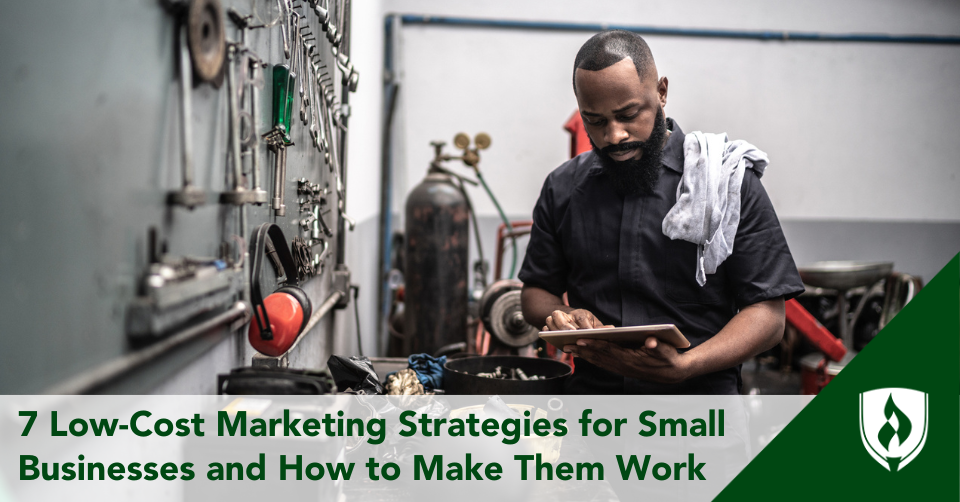7 Low-Cost Marketing Strategies for Small Businesses, and How to Make Them Work
By Hope Rothenberg on 08/29/2023

When you hear the terms “marketing plan” and “marketing budget,” you might immediately think of a large corporation or franchise business. The reality is that every company – even and especially a small business – can have a marketing plan and budget.
The good news is that putting together a marketing strategy doesn’t need to break the bank. There are tons of free or low-cost marketing strategies that can be effective in boosting your small business customer base and helping to increase sales.
Here’s our roundup of the top seven low-cost marketing strategies for your small business and how to make them work. Additionally, if you're interested in understanding more about consumer perceptions and market positioning, delve into our article on "what is perceptual mapping".
1. Put together a simple marketing plan
The first step for any small business exploring new marketing strategies is to put together a plan. It might sound like a big lift, but it doesn’t have to be intimidating. Learn what to include in your marketing plan with this easy guide from the Small Business Administration (SBA).1
What’s the goal? Estimate the breakdown of your current customers. Also, do some market research on your target market, your target audience and how much you’re spending on different marketing strategies. Leave a space to record your returns and use it as a placeholder to keep track of which marketing initiatives work, which don't and what else you want to try.
2. Create a marketing budget
Part of your marketing plan will be a marketing budget. But how much should you budget for your small business's marketing efforts?
“If you think of marketing spending as eating into your profits, you’re thinking the wrong way. Marketing isn’t an expense – it’s an investment, one that drives your sales2,” writes the SBA.
There’s no set rule for how much money you should allocate to your marketing budget, though many businesses use a percentage of revenues or projected revenues to help them determine a starting number. Naturally, this percentage varies by business type and industry.
The average business spends 1.08% of its revenues on advertising, according to a Small Business Trends report. Retailers tend to spend more like 4%, and restaurants more like 1.93%.3 Use these trends as a rough guide for your own business and try them out to see what works for you.
3. Contact your local SBA branch for assistance
The SBA has smaller branches dedicated to providing resources for local small businesses. Not only do they offer financial help for business owners who qualify, but they also offer mentoring, coaching and consulting.
Head to the SBA’s Local Assistance page to get started and see what resources may be available to you. The best part? Many of these programs are free.
4. Perfect your elevator pitch
As a small business owner, you already know the importance of word-of-mouth marketing. It might be all you’ve relied on so far, and just because you’re exploring other tactics doesn’t mean you should stop using it to reach your target audience.
Spreading the word around town and generating buzz in your community is important. Often, you never know who you might be talking to when you pitch your product or service to a stranger.
Rather than wing it every time, come up with a well-thought-out, short elevator pitch you can memorize and tailor as needed when the opportunity strikes. The SBA often hosts free workshops on perfecting your elevator pitch, and these are some commonly referenced best practices.
Your elevator pitch should:
Be less than 90 seconds
It’s called an elevator pitch because it has to be something you can say during the average length of an elevator ride. Record yourself reciting it a few times, and make sure it’s as concise as possible while still covering the essential purpose of your business.
Communicate what you do
Talk about what you do, along with why you do it and how it can make the life easier of whoever you’re talking to. It’s that simple.
Use the word “you” more than “I”
Nobody wants to hear someone else talk all about themselves during a conversation. Focus primarily on what your business does for its customers, and use your pitch as an opportunity to address a target customer directly. Odds are, they’ll be much more receptive.
Ideally, you’ll hand that person a business card, a flyer or something else after your pitch, something that allows them to follow up if they’re interested.
5. Make some business cards
People may think that the days of business cards are over, but a small piece of paper or digital business card can go a long way. If you don’t already have business cards, consider getting a few printed.
Business cards are an easy way to share your information; every time someone glances at it in a wallet or on a counter, they’ll be reminded of your business. Plus, business cards show that you take your business seriously and that others should, too.
There are a bunch of easy, user-friendly websites you can use to create some customized business cards. Popular choices like Vistaprint® are quick and easy to navigate; there are also different options to make your business cards as simple or as sophisticated as you’d like.
A design platform like Canva® allows you to create anything and everything you might need for marketing your small business. Use its business card templates to create your design and print them yourself for free, or use Canva’s printing services. It costs as little as $14 for 50 cards, and they offer free shipping.
Wherever you source your cards, be sure to save the design as a digital file or screenshot. This image can double as a digital business card, letting you email or text it to potential customers if you’re in a rush or don’t have paper business cards on hand.
6. Commit to community networking
As a small business, your community is everything. That doesn’t just apply to your customers but to the other smaller, local businesses in your area.
Networking and collaborating with other businesses can help you build awareness, form connections, and expand your reach. There are also tactics you can learn from other business owners and lay the groundwork for mutually beneficial relationships.
Join online networking groups
From community-based LinkedIn and Facebook groups to your local chamber of commerce site, there’s a ton of platforms and search engines. They have spaces dedicated to knowledge sharing amongst small and growing businesses.
Attend local business mixers
Depending on where you’re located, there may be local business fairs or mixers where you can meet other owners and market your business. Can’t find one online? Consider connecting with local companies to host a block party together and create your own.
Sponsor a charity
Local 5k? PTA fundraiser? Park cleanup? Make a small donation in your business’s name and set up a stand at the event. Even if you’re just handing out water bottles, it’s an opportunity to meet new people and get your name out there, all while participating in something your community already cares about.
Speak at an event
Whether it’s a small business convention or the local library, community-organized events are often in need of speakers. Volunteer to speak about your journey as a small business owner, a pressing issue for the community or anything else you’re passionate about. Small business marketing isn’t always about selling your product; it can be just as much about selling yourself.
Getting more involved with your community by networking and volunteering can only help your business, and the only thing it needs to cost you is some time.
7. Grow your customer relationships
Small business customers are some of the most loyal customers out there. It isn't always because your small business put together a multi-stage marketing campaign strategy or paid for an ultra-professional looking website. The business to customer relationship is personal – and people value a personalized experience.
About 37% of Americans say they purchase from small businesses to receive a more personal experience, according to a NerdWallet survey of over 3,000 U.S. adults. In that survey, 92% of the respondents said they spent money at small businesses, and 30% say they’re willing to both wait longer and pay more for products and services purchased at small businesses versus at a major retailer or chain store.4
Customer loyalty is there, so why not try to retain and grow it? Consider some of these tactics to incentivize – and reward – your loyal small business customers.
Start a referral program
You already know the value of word-of-mouth marketing, so why not enlist your existing customers to help you out? Offer small incentives for new customer referrals. Whether you offer free shipping, a store discount, or a cash reward, it'll build brand awareness and help you reach new customers.
Launch a customer loyalty program
Customer loyalty programs have been prevalent for quite some time now, and that’s because they tend to work. Start a loyalty program where repeat customers can accrue points and eventually get some sort of reward.
Plan a giveaway contest or offer a free gift to your best customers
Everyone loves free stuff. If you already have a strong online presence, you can organize a giveaway contest and build some buzz that way.
An even simpler option is to do a round of gifting. Next time you have a new product or service you’re promoting, give it out for free to some of your most loyal or well-connected customers. Ask them to share it with their friends or clients in return. It may seem counterintuitive, but giving something away for free can lead to even more sales.
Start small with your small business marketing strategy
When it comes to figuring out your small business marketing strategy, it can be hard to find a balance between not doing enough and trying to do too much too fast. Before you dive into things like email marketing, social media platforms, Google Ad Network™, keyword research and search engine optimization, make sure you use essential marketing tactics.
Steps like making a marketing plan, putting together a marketing budget, and ensuring you’re equipped with the essential tools for community networking and word-of-mouth growth can go a long way. They are necessary building blocks before you put together more sophisticated marketing campaigns.
There's a lot to know when it comes to running a small business. So much to know, that it can feel like you are always a few steps behind. That's normal! But if you are at the point where you could use a firm foundation to stand on, check out 4 Great Degree Options for Small Business Owners and Entrepreneurs. Getting the know-how you need to make your business successful doesn't have to be trial and error.
VistaPrint is a registered trademark of VistaPrint USA
Canva is a registered trademark of Canva Pty Ltd
Google Ad Network™ trademark is owned by Google LLC
1U.S. Small Business Administration (SBA), Marketing and Sales [accessed August 2023] https://www.sba.gov/business-guide/manage-your-business/marketing-sales#id-make-a-marketing-plan
2Rieva Lesonsky, How to Get the Most From Your Marketing Budget, (July 9, 2019) [accessed August 2023] https://www.sba.gov/blog/how-get-most-your-marketing-budget
3Small Business Trends, How Much do Small Businesses Spend on Advertising? [accessed August 2023] https://smallbiztrends.com/2023/07/how-much-do-small-businesses-spend-on-advertising.html
4NerdWallet, Small Businesses Face Economic Strain Even With Loyal Patrons [accessed August 2023] https://www.nerdwallet.com/article/small-business/2022-small-business-report




